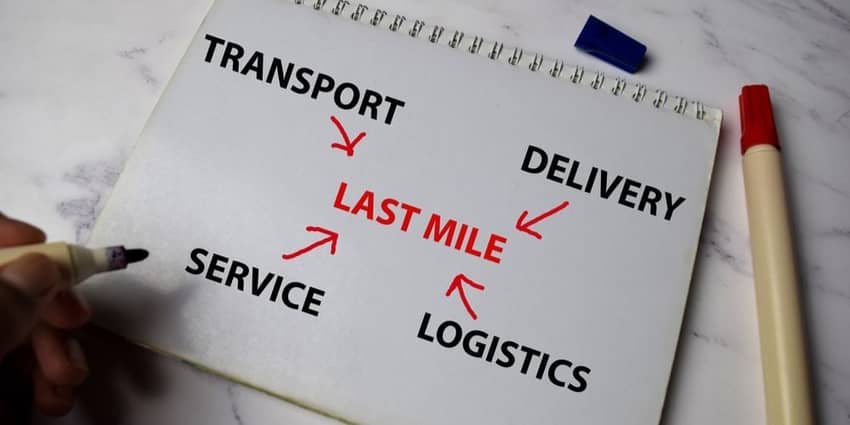As a retailer, you might not believe you have any control over last-mile delivery.
But you actually do.
You are responsible for several factors that can contribute to how quickly a parcel is delivered. Missing even one of the steps can delay its delivery, leading to unhappy customers and potentially additional charges from the courier company.
In this article, we’ll dive into the intricate details of last-mile delivery and the benefits of having a strategy in place. You’ll also find exclusive tips from our experts to help get your parcel into customers' hands faster.
Let’s jump in.
What Is Last-Mile Delivery?
Last-mile delivery refers to the final step in the fulfilment journey. It’s when the parcel leaves the warehouse and arrives at the recipient’s location.
It’s the most critical part of the delivery. Both couriers and retailers want to ensure the item is fulfiled as quickly as possible. But, this comes at a cost and makes last-mile delivery the most expensive part of the process.
What’s Involved in the Last-Mile Process?
The last-mile process isn’t complicated. These are the five steps involved.
- Order Is Placed
Your customers make a purchase on your online store. You take the necessary steps to fulfil the item and prepare the parcel for collection from a courier company. - Parcel Arrives at Shipping Warehouse
The package is organised into groups based on the delivery service selected and the destination. It may need to get transferred to another shipping warehouse, depending on where it is going. - Package Is Assigned
The group of parcels is assigned to a courier driver. Some factors that influence the decision are the delivery route and schedule, shipping service and the vehicle's capacity. - Item Is Loaded Onto the Truck
All of the parcels are scanned before being placed into a delivery vehicle. This assists real-time tracking software so personnel can identify the package's location throughout the journey. It also reduces the risk of items going missing. - Delivery Is Completed
The driver leaves the parcel and collects proof of delivery. It might be taking a photo of where they left it or a signature from the person who received it.
What Are the Challenges of Last-Mile Delivery?
While the process seems simple, significant challenges make it complex. These are just some of the most common issues.
Higher Delivery Volumes
After 9.4 million households made an online purchase in 2022, the volume of parcels out for delivery is higher than ever. With courier companies unable to keep up with the demand and battling to keep costs down due to inflationary pressures, items are taking longer to arrive at their final destination.
Lost Parcels
Multiple delivery attempts drive up the costs of shipping. It can occur when people aren’t available to accept their parcel or when a package is stolen when it’s left unattended.
This often happens when customers aren’t made aware of when to expect their delivery. With the use of tracking notifications or portals, shoppers can plan ahead and make sure they’re home when the courier arrives.
Returns
Australia Post found that 26% of shoppers returned a product in 2023. Reversing the logistics process to the retailer doubles the cost of shipping.
As the number of returns looks to increase, it can have a harmful impact on fulfilment costs and last-mile delivery.
Weather Events
The number of severe weather events continues to increase year on year. Floods, fires and damaging winds not only wreak havoc on homes but also impact delivery routes.
The result is delays in getting parcels to customers and potential damage to packages depending on the weather event. Communication with shoppers is vital during these times to ensure they’re kept in the loop as to when they can expect their delivery.
The Benefits of an Effective Last-Mile Delivery Strategy
There are several advantages to your business and customers when you implement a last-mile delivery strategy. Some of these benefits include:
- Faster deliveries: Making last-mile delivery a priority can assist in getting your parcels into the hands of your shoppers faster. By understanding what factors you can influence, you can ensure packages arrive on time.
- Happier customers: When parcels arrive within the expected timeframe, you build trust with your customers. Exceeding their expectations can lead to glowing reviews and positive social media sentiment, leading to referrals.
- Increased sales: Satisfied customers are more likely to shop at your online store repeatedly. Proving that you are reliable and can provide consistent post-purchase experiences will lead to more sales from loyal shoppers.
- Higher revenue: Optimising your fulfilment will help your bottom line. Meeting customer expectations and streamlining your operations to avoid returns and delays in delivery will save you money on replacements and surcharges from couriers.
- Efficiency gains: Integrating automation tools and technology solutions can help with last-mile delivery and save you time on your fulfilment operations. Choosing the right provider can give updates to customers on the status of the parcel and provide recommendations on the most efficient way to pack a multi-item order.
What Is the Last-Mile Problem?
The primary issue with last-mile delivery is the cost of getting parcels into customers' hands as quickly as possible. As expectations continue to increase, the cost to meet the demand grows.
It becomes more challenging for rural areas where there are limited deliveries and longer distances between residences. However, it can also be difficult for metro areas where congested traffic and regular roadworks affect delivery routes.
What Are the Costs of Last-Mile Delivery?
According to Capgemini, last-mile delivery accounts for 41% of the fulfilment cost. It’s why optimising your shipping strategy to manage these margins becomes essential, particularly during peak sales seasons like Black Friday and Cyber Monday.
How Can You Avoid Last-Mile Delivery Delays?
The good news is there are simple strategies you can implement that can positively impact last-mile delivery. Here are ten tips we recommend that you start doing today.
- Regularly review the Branded Tracking Portal and watch for orders lost in transit. To resolve this issue, contact our customer service team, who have direct access to couriers and solve problems faster.
- Use the Shipping Manager address validation feature to double-check that customers have provided the correct information for their orders. It will avoid redelivery costs.
- Review the Prohibited and Restricted items to ensure your products are eligible for delivery from your preferred courier. If it isn’t, the package will be abandoned.
- Ensure your custom documents are accurate and include all the required information. Pay all your fees immediately to avoid any delays from the border forces.
- Attach your label to the top or side of your box. Ensure it is clear and legible for everyone to read.
- Personalise your parcel with your logo or colour scheme to stand out amongst a crowd of brown boxes. It will come in handy if there is an issue at the shipping warehouse and someone needs to locate it.
- Be available when your package is scheduled to be collected. Failing to do so may incur fees and rebooking charges.
- Provide estimated delivery timeframes in correspondence to customers. This is vital, especially for services without authority to leave.
- Always choose the appropriate service for your needs. For example, Pallet No Taillift services mean the driver will not have a forklift. If your pallet requires one and you book this offering, it will not get delivered.
- Research the service areas of couriers. Some providers specialise in rural deliveries, and others are faster in metro locations.
How to Get Started
Last-mile delivery will be an ongoing challenge as customer expectations continue to increase and the costs to fulfil parcels rise. But by streamlining your operations and following these simple strategies, you can reduce delays and surcharges, leading to happier customers and higher sales.
Need help optimising your fulfilment strategy? Speak to our team of shipping solution experts who can tailor our platform to your needs. They’re available via phone, live chat and email. Contact them today!










 Facebook
Facebook Twitter
Twitter Instagram
Instagram Linked In
Linked In YouTube
YouTube